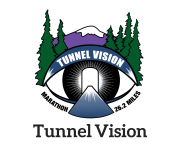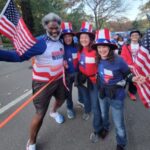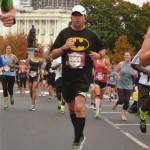This race is self explanatory. If you can't explain it yourself, you need to go run it. As many know, whatever your best time is in the full marathon, take … MORE
This race is self explanatory. If you can’t explain it yourself, you need to go run it. As many know, whatever your best time is in the full marathon, take 15 to 20 minutes off. But there’s a catch.
Will you be able to catch your breath? From the paxket pickup to picking up your jaw off the ground, the sites and scenery will take away your breath if the running of the course doesn’t first. Words cannot describe what you’ll experience. And if you and I were face to face, I could only give you a huge smile and shake my head.
Speaking of heads, hold on to yours. After you complete this marathon, that’s what you’ll need to do. Your PR will have you feeling like you ran a sub 2 marathon. If you don’t get the big head and float away, I don’t know what will make you feel like you’re ready to just explode.
Although I didn’t finish the full, I was able to get halfway through the course before pain from my wounds took me out. I’ve ran this course multiple times, and it never ceased to amaze me. Neither will you.






Come,ride this trail — Choo Choo ride it
This race is self explanatory. If you can't explain it yourself, you need to go run it. As many know, whatever your best time is in the full marathon, take … MORE
This race is self explanatory. If you can’t explain it yourself, you need to go run it. As many know, whatever your best time is in the full marathon, take 15 to 20 minutes off. But there’s a catch.
Will you be able to catch your breath? From the paxket pickup to picking up your jaw off the ground, the sites and scenery will take away your breath if the running of the course doesn’t first. Words cannot describe what you’ll experience. And if you and I were face to face, I could only give you a huge smile and shake my head.
Speaking of heads, hold on to yours. After you complete this marathon, that’s what you’ll need to do. Your PR will have you feeling like you ran a sub 2 marathon. If you don’t get the big head and float away, I don’t know what will make you feel like you’re ready to just explode.
Although I didn’t finish the full, I was able to get halfway through the course before pain from my wounds took me out. I’ve ran this course multiple times, and it never ceased to amaze me. Neither will you.
Stunning scenery, PR & BQ
This is a beautiful course developed from old railway into the Washington “Rails to Trails” trail system. I have run on this trail 3x now (1st time to race it). … MORE
This is a beautiful course developed from old railway into the Washington “Rails to Trails” trail system. I have run on this trail 3x now (1st time to race it). It winds along the evergreen-lined mtns with steep valleys and numerous bridges. I looked over the edge of one of the bridges and felt woozy from the height. The downhill is gentle but starts to take a toll on the legs by mile 20, so I went faster than I normally would in the 1st 1/2.
Unfortunately there was a snaf-fu with the water stations between 14 & 20. I didn’t even realize the gaps were consecutive until I finished (not alot of glucose going to the brain). There were alot of runners walking in the last 5 miles which is super dis-heartening. Who knows if this was due to the lack of hydration or just overshooting their speed. I did PR by almost 12 mins which was nice, but the course was challenging for me because I kept slipping with almost every stride.
The tunnel at the start was very bright with everyone’s lamps, better than the last time I ran it 3 wks ago (…I ran straight into the wall!). During the middle of the race, I only had water twice after mile 13, which is not optimal, its a miracle I did get crampy muscles. A few rocks got in my shoes, but they were small and I ignored them until the end.
All in all, I still would recommend this race to anyone interested in running in tall evergreens on super speedy trail. I live south of Seattle, but we still stayed close to North Bend the night before. Next time we will stay in/near Seattle bc the hotels are nice & the food is more diverse (fantastic). Other than the hydration station issues, the production was wonderful, I am confident they will correct this for next race! The finish was very festive with lots of yummy food.
Not a good race all around
First and foremost, I came into this race battling a Peroneal tendon issue that flared up again at mile 4 and essentially left me limp running by mile 21 and … MORE
First and foremost, I came into this race battling a Peroneal tendon issue that flared up again at mile 4 and essentially left me limp running by mile 21 and walking by mile 23. That has absolutely nothing to do with the race itself or the race directors and did not color my thoughts and impressions of this race.
The location of the race just east of the Seattle area is a beautiful trail made up of very compacted gravel and winds its way gently down a mountainous park area. The views are spectacular as you cross over many suspended bridges looking high over creeks and small water falls. The mountain tops just in the distance can’t be seen for the clouds and mist that hang in the air around them.
As mentioned, the trail is compacted gravel, I never had a moment of losing my footing or having to dodge large rocks or roots. The race directors mention the advantage of wearing gators on your shoes, but I only had one instance of a rock getting in my shoe and having to stop to remove it. The downhill track is never overly steep and almost has no uphill at all, it’s gentle enough to feel good but not have your quads ready to burst.
The name sake tunnel is a unique experience. Running in total darkness with only head lamps for light makes for a surreal experience of running in and amongst head lights that varied in brightness and range. Seeing the pin prick of light at the end of the tunnel slowly grow until you emerge on the other side is definitely an experience unique to this course. The organization on the other end of volunteers collecting your drop bag to return your head lamp to the finish line was well run and efficient as well.
Communication from the race directors leading up to race day is good, monthly emails with plenty of news and information. The location near Seattle is easy to get to and the race area is close enough to the city to be able to take in some sight seeing in Seattle the days before the race. I had no trouble getting an affordable hotel room or a rental car.
Unfortunately, the organization on the course was not on the same level. Since the water and aid stations were further apart than typical marathons, I carried a handheld water bottle with me for consistent hydration. This wound up being what saved me during the toughest miles of the race. At mile 15 I took nutrition and salt tabs using the remainder of my water knowing there was an aid station coming at mile 16 for a refill and sports drink to balance out all the water. For me, the miles from 14 to 20 tend to be the most mentally challenging as I’ve run almost to end of my glycogen stores but still have a lot of race left. Mile 20 is always a big boost for me, something mentally about hitting 20 and having only a 10K left always gives me a nice kick at the right time. So rounding the corner into Mile 16 and finding the water and aid station completely abandoned was the exact opposite of the kick I really needed. I initially panicked having just finished the remainder of my water. Fortunately, I was able to cobble together the remaining water out of several of the abandoned cans to be able to re-fill my bottle. Working with several other runners who were coming in behind me, we able to get ourselves hydrated enough to continue.
At this point, heading out of the abandoned water stop, I was mentally frazzled as well as dealing with the Peroneal issue. Out of concern for the unknown status of future water stops, I was overly conservative about drinking much from my bottle as I continued to run. Coming into Mile 18 confirmed the worst fears as that stop was also abandoned. Again, several of us cobbled together water from the cans left scattered on the ground, but there was no sports drink nor any medical personnel. I definitely had the though of what happens if someone gets seriously injured, we are literally in the middle of nowhere, no spectators, no race officials, no medical personnel.
As in Mile 16, I headed out from the Mile 18 abandoned stop concerned about my growing injury issue and the continued availability of fluids. Needless to say, this is not a good mental situation for a marathon. Thankfully, the Mile 21, and 24 station had 1 volunteer still there with sports drink at Mile 24 to break up the water, but by that point I was so mentally and physically out of the race it didn’t make much difference.
I’ve never written a negative review for a race and hate to do so now, but I would absolutely not recommend this race. Until you run this trail, it’s hard to appreciate how isolated it is. When the aid stations are abandoned I’m not sure how much you could depend on getting aid if something bad happened during the run. It was to the point where several of us were wondering if there had been some type of horrible incident in the Seattle area as the reason all the volunteers and medical personnel abandoned their stations. My injury issue caused my horrible performance, that is absolutely not on the race directors. However, there is no excuse for leaving so many of us on an isolated trail with no support for almost 10 miles (Mile 12 to Mile 21). There are several organizations that use this trail for marathons, I would suggest researching those groups and running the course with them.
Tunnel Vision Marathon Race Report
This is a race report that I don’t know exactly how to write. It is uncharted territory for me. Usually, the gist of my race reports is this: the race … MORE
This is a race report that I don’t know exactly how to write. It is uncharted territory for me. Usually, the gist of my race reports is this: the race was wonderful; I had a fabulous time; I would recommend this race to everyone. Well, this race was wonderful; I would recommend this race to everyone, but, I most definitely did not have a fabulous time.
First, this is a seriously fast course. It is without a doubt the easiest marathon course I have ever run. I just wasn’t having a good day.
The race, a point-to-point, started about an hour east of Seattle at Hyak in Snoqualmie Pass. My hubby Bill drove us to the race start, which meant we didn’t have to ride the shuttle bus, always a plus. It was chilly at the start, so we were glad to be able to sit in our car to wait. You can pick up your race bib the day of the marathon, a nice perk.
A unique feature of this race is the old railroad tunnel that you run through beginning half a mile into the race. Runners are instructed to wear headlamps or carry a flashlight. The tunnel is almost 2.5 miles long, and it is completely dark inside. I never felt claustrophobic, however. There are hundreds of runners, all wearing lights, going through the tunnel at the same time. You can see the light at the end of the tunnel almost a mile before you reach it, so that gives you a nice point of reference.
You can read my full race report here: https://meditationsinmotion.wordpress.com/2018/08/24/tunnel-vision-marathon-race-report/
Boston, here I come! (with caveats)
QUICK BITS - USATF-certified marathon is eligible as Boston Marathon qualifier. - Gentle downhill course offers a chance for faster times (with some caveats) - Small race with friendly organizers … MORE
QUICK BITS
– USATF-certified marathon is eligible as Boston Marathon qualifier.
– Gentle downhill course offers a chance for faster times (with some caveats)
– Small race with friendly organizers and volunteers
– Unpaved bicycle trail course puts less shock on the body, and is not technical
– Most famous for the 2.5-mile pedestrian tunnel at the start of the race; you won’t run through anything like this on any other marathon
EVENT INFO
[If you want to run this race specifically to qualify for the Boston Marathon, scroll down to the section labeled “COURSE CAVEATS”.]
The Super Tunnel Marathon is the newest sibling in the Tunnel series; added in 2016 in response to popularity of the Light at the End of the Tunnel (held in June) and Tunnel Light (held in mid-September) races.
This is a popular course and in the last few years, has seen the addition of the Jack and Jill Downhill Marathon, put on by a different race organization. [This review is for the Tunnel race only, and does not reflect any evaluations of the Jack and Jill race, which I have not run.]
Although Super Tunnel is brand new, since the race director has been offering the Tunnel races for many years, this has a feeling of a seasoned race. The race website looks like it came straight out of the 1990s, but is perfectly functional and you can register for the race just fine.
One of the pluses for this race is that it’s USATF-certified, so your official time is valid as a Boston Marathon qualifier. If you don’t want to wait until right before the registration for Boston opens in mid-September, running this race versus its later offering (Tunnel Light) is a good option. For those who can manage two marathons within a month, you could run this one, then run Tunnel Light a few weeks later to see if you can improve your time (to either qualify for Boston, or to improve your placement for Boston if you already qualified).
The focus is not just on Boston hopefuls, however. This is a beautiful and scenic race that offers a wonderful view. If you are a slower runner or walker, the gradual downhill means you can enjoy the distance without completely wearing yourself out from going uphill. If you think you might take longer than five hours, this race offers an early start option; start one hour earlier, and you get an extra hour on top of the 6:30 time limit (that means you get 7 hours 30 minutes to hike this downhill course).
The starting area is a nice little open parking lot by the course trailhead, but race organizers strongly discourage participants from going there directly. Instead, you are encouraged to park at a lot near the finish line; they offer a free shuttle bus ride to the start line.
The finish area in North Bend has limited hotel options–what we did was to stay in the Seattle/Bellevue area and drive to the parking area early in the morning. The early start was at 7:00, and we caught the 6:00 shuttle from the finish area and got there in plenty of time to watch the early folks take off (this meant we left our hotel at 5:30; not terrible for a morning race). The regular race start is 8:00.
The shuttle bus from parking lot to the race start was around half an hour.
PRE-RACE DETAILS
This is an extremely low-key trail race. There’s no fitness expo or early bib pick-up. You don’t even get your bib before the shuttle ride. You just catch the shuttle, show up at the starting area, and get a bib. In fact, they don’t even assign you a bib number until you show up; it’s that low-key.
Race organizers are very good about communicating all this information, and as race day nears, you will get a couple of emails providing last-minute details.
THE COURSE
The most unusual part of this course is the beginning, where you run through almost two and a half miles of the Hyak Tunnel, a narrow tunnel wide enough to fit a car. There are no lights in this tunnel, so you will be running through pitch blackness; race directors strongly urge you to bring some form of light.
I wore my baby headlamp that clamps onto my visor bill, as well as a $1.00 WalMart light, and these sufficed ONLY in lighting the runners ahead of me–and I used the runners in front of me to guide me forward. Had I been the only one running, my lights would have been pretty weak.
Once you leave the tunnel behind you, the rest of the course is all on an unpaved bicycle path that’s on a gradual downhill. Think of it as essentially a fire road with mostly packed gravel. There are a few slightly looser spots but nowhere is there anything remotely technical on this trail course, unless you count the inside of the tunnel (since you can’t see where you’re going, and you’ll be stepping through some puddles and such).
The course is beautiful, and there were three bridge overpasses you run over. The whole area is just magnificent, with lots of tall green trees. Coming from Northern California with its years-long drought, seeing so much green (and breathing the fresh air) was just spectacular.
The course is not closed for the race, so you’ll periodically come across other hikers, mountain bikers, and even some rock climbers.
Mile markers looked like they were laminated cardstock sheets posted on orange safety cones, but there are so few distractions on the course that the markers were always very visible and easy to read.
The Tunnel races always have official pacers (people who hold up signs of what time they expect to finish by, so that if you stick with them, you can finish at around that time).
AID STATIONS
Aid stations are small and spread out, but very very friendly, with always a smiling face, always helpful; just not a lot of extras. Some had porta potties. A few official bathrooms along the trail. The race website lists 10 aid stations; they are roughly 2-3 miles apart. The site also spells out exactly what to expect at each one (water, gatorade, Clif Shot Enery Gel, etc.).
If you don’t want to slow down too much to hydrate at the aid stations, consider bringing your own water source, whether it be a bladder backpack or a bottle in your hand. I relied just on aid stations and I’m sure I was dehydrated by the end of the race.
BLING
Goodies are plain but solid. You get a finisher’s shirt at the finish line, and they are gender-specific tech shirts. You also get a nice smaller finisher’s medal with a custom lanyard. They do not give out age group awards, but you can view the results to see how you placed. It’s a small race so if you’re relatively fast, you have a good shot at placing in your age group.
POST-RACE INFO
The post-race area included plenty of water bottles, volunteers handing out medals, a big spread of food, a tent to pick up finisher’s shirts, an area to get your gear bag, plus the best area for me — the massage tent. They actually had three massage therapists set up, and Todd, who helped me, was fantastic. They charged $1 a minute.
For a small race, these folks put out a pretty good spread at the finish line. In the shadows of Seattle and the headquarters for Costco, the smorgasbord is thanks to a trip to the warehouse store. We enjoyed lots of watermelon and cut up fruit, sheet cake, potato chips, cookies, sodas, water, and much more. The highlight was hot chili! OK so may they came from big cans at Costco, but after running a full marathon, a cup of chili feels much more substantial than just sweet or salty snacks. It’s something you’ll find at an ultra-marathon race, but not often for a marathon. For me it was a welcome treat (and they provided all the fixins as well; sour cream, chives, tortilla chips!).
COURSE CAVEATS (BQ RUNNERS: READ THIS!)
If you are running this race to BQ and every second counts, heed these caveats.
#1: Pacers: There are inherent issues with the pacer time offerings, because unlike some BQ-focused races, times butt right up to actual qualifying times, rather than giving you a cushion of a couple of minutes (that is, 4:00 instead of 3:58, etc.). Offered for this race were 3:15 (BQ for M40-44), 3:30 (BQ for M50-54), 3:40 (BQ for M55-59; W35-39), 3:50, 4:00 (BQ for W50-54), 4:15, 4:30, 4:45, 5:00.
As you can see from this list, only four of nine pacers were tapped to meet exact Boston qualifying times. These pacing times are fine for those who simply wish to meet these finish times, but seeing as this is prominently marketed as a Boston qualifier, be mindful that your desired pace may not be offered.
For example, my BQ time is 4:00, but I did not want to finish *AT* 4:00 because that would not be fast enough to meet the cutoff. For me, the optimal pacer would have been 3:57 or 3:58. Without one, my next option would have been a 3:55, but that pace was not offered at all. This meant that in order to stay ahead of the bare minimum, I would have needed to stay with the 3:50 pacer, considerably faster than anything I would normally be able to keep up with.
This may just be a matter of pacer availability, but having more pacers would have been helpful (for example, more BQ-time pacers and fewer slower pace times).
#2: GPS: Do not rely on your GPS watch to keep track of you while you run in the tunnel. If your GPS watch has the ability to track you via shoepod or you can mark the miles manually on it while in the tunnel, do so. Make sure you start your watch when you start the race, and verify, before you turn around the corner and head into the tunnel, that it’s found the GPS satellites and that it’s working.
Even then, expect your GPS mileage to be considerably off. This course is heavily shaded, with lots of turns around mountainsides.
The only TRUE thing you should rely on, is your TIME ELAPSED stat. If seconds matter in your finish time, wear a pace band (or write the times on your arm) that shows mile markers with total time passed. This is the best way to rely on whether you are on track.
#3: The TUNNEL: This course is not technically difficult, but the tunnel is disorienting, and it will be very hard for you to keep track of your pace. If at all possible, find other runners (or a pacer) going around your pace, and stick with them through the tunnel. The darkness of the tunnel could cause your pace to vary.
You are given the option to check your flashlight in with a separate gear bag at the end of the tunnel. Should you choose to check your light here, you can put it in your bag in the dark while you run, and volunteers will catch your bag as you toss it to them–but my recommendation is to you wear a headlamp and keep it on your head after the tunnel so you don’t have to stop to drop off your bag.
Also, aid station #1 is at this same location. It’s immediately outside the tunnel, so if you aren’t expecting this, it’s easy to miss your chance at getting some water. Just be ready; the tables are to your right.
#4: “GRADUAL DOWNHILL COURSE”
The race describes it as a “fast downhill course” and with the combo of prompt notification to the BAA of race results, this course is designed for the BQ runner in mind. That said, this downhill course is deceptive.
Yes, it’s a wonderful gradual decline. The course is never technical, the downhill never steep. There is maybe a 20-yard stretch that’s a very slight rolling uphill, but everything else outside the tunnel is a downhill.
But.
The course isn’t paved. While unpaved and compact gravel means less wear on your joints, it also means you need to be mindful where you step so you don’t take a gravely misstep.
You also can’t afford to stop to take pebbles out of your shoes, so gaiters are a must. The race website recommends Dirty Girl Gaiters; while I like them, I prefer UltraGam gaiters from Etsy. They offer a wider range of prices, and their down-facing hook is much easier to remove than the up-facing hook Dirty Girl uses.
The gravel takes a toll on you. That, with the added extra speed of a downhill course, means you MUST train for hills. This course is gradual, but still. Train for the downhills–your quads will get a definite workout.
TIPS — Based on my experience, here are my personal suggestions:
– Bring your own water to help augment what’s offered at the aid stations.
– Bring your own fuel if you want something other than Clif Shot Energy Gels.
– Wear a headlamp for the tunnel, then leave it on your head and don’t bother checking it in so you can avoid slowing down your pace if you’re trying to meet a finish time goal.
– Wear a pacing wristband or write down key mile splits on your arm; do not rely on your GPS to track you after the tunnel correctly.
– Wear a pair of gaiters around your ankles to avoid pebbles from getting into your shoes.
GENERAL THOUGHTS
This race is all it’s cracked up to be. It’s both a trail race, but not technical–and also fast. That downhill course is deceptive, though; definitely train for it. I wound up with a severe charley horse on my left calf that almost incapacitated me in the last five miles of the race. I stopped a few times to massage it out and was able to keep running, but at a much slower pace. I was fortunate to have enough of a cushion from earlier in the race that I was still able to make my BQ time, but my finish time was considerably slower than had I not had a calf that seized up on me.
I’ve never raced with a cramp that bad before, and I suspect it was due to an angry piriformis (pain in the glute for me) and my leg compensating for this with a slightly altered gait, and pushing for a faster-than-normal pace because the downhill course let me push myself. Add to that, that I was probably dehydrated, and I consider myself fortunate that I still BQed.
If I run this race in the future, I will know a lot about what to expect. Without the charley horse, I’m sure I would’ve finished at least a few minutes faster.
All in all, though, this is a wonderful and unusual race. The tunnel is a real experience, and different from anything I’ve run before. The volunteers were all friendly and supportive, without exception. Things were low-key but run very smoothly.
I would definitely recommend this course. If you’re trying to find a small certified Boston qualifier that’s fast point-to-point course with a gentle downhill, definitely give this a consideration.
On the other end of the finish clock, this is also a very hiker-friendly race. With the early start option and the gradual downhill, you can really enjoy the scenery and you should be able to make the cutoff time as long as you keep moving at a reasonable clip.